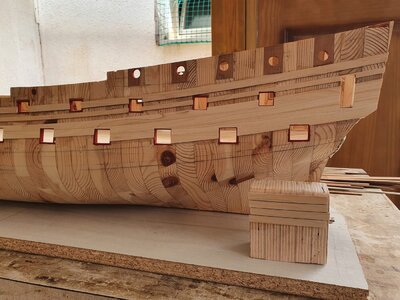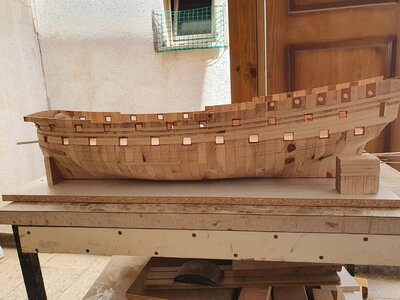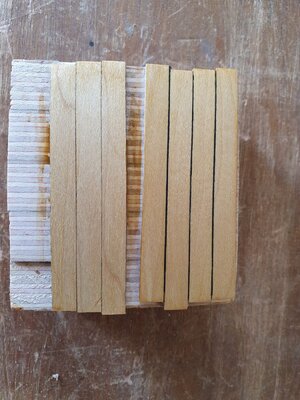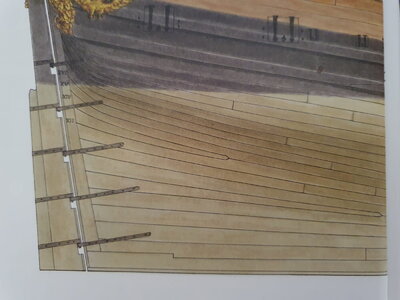-

Win a Free Custom Engraved Brass Coin!!!
As a way to introduce our brass coins to the community, we will raffle off a free coin during the month of August. Follow link ABOVE for instructions for entering.
-

PRE-ORDER SHIPS IN SCALE TODAY!
The beloved Ships in Scale Magazine is back and charting a new course for 2026!
Discover new skills, new techniques, and new inspirations in every issue.
NOTE THAT OUR FIRST ISSUE WILL BE JAN/FEB 2026
You are using an out of date browser. It may not display this or other websites correctly.
You should upgrade or use an alternative browser.
You should upgrade or use an alternative browser.
HMS St Albans (1687) model in scale 1:48
This is really good and a fascinating study in lines; I am particularly interested in the forward tumblehome below the forecastle deck, and the way that it transitions into the head timbers. With the entire head-structure, in place, this is not nearly as noticeable, but in the framing stages, it is quite pronounced. I'll be following this one!
- Joined
- Sep 7, 2020
- Messages
- 27
- Points
- 78

Hello friends!
I apologize for the long absence.
I had to switch all my efforts and thoughts to looking for work (and this process, unfortunately, has not yet been finalized) - as a result,
the progress with the ship almost stopped.
But, a little about progress in work:
A surprise was the variable width of the main planking boards - four planks located between the upper and lower wales - are equally wide in the area of the aft galleries, towards the bow they smoothly taper by 18 percent of their width
Having made every effort to accurately reproduce the width of the strips and to properly fit the frames of the gun ports,
I underestimated the thickness of the strips in several places.
Perhaps this can be somehow disguised later (for example, leaving the covers of the cannon ports open so that the difference between their thickness and the thickness of the side will not visible),
but then the following problem arose: when I finally went to the last, bottom row of cladding, and sanded the surface at this point,
the result was very disappointing to me - . Maple, of course, is very beautiful in itself, but the grinding hid the boundaries between the planks, and the surface began to resemble a beautiful one-piece wall panel and not the side of a shipboard .
.


It's sad - but I have to remove the skin and do all four planks again.
For the desired choice of the boundaries between the boards, I built a test:
in the first version (in the right) I glued black paper between the planks,
in the second (left) I painted the border with acrylic along the planks.
Well, at the same time I covered both probes with oil with a pigment that gives the maple an amber hue.

It became clear that the first option (0.3 mm between the planks) is suitable for the deck. Of course, with a more thorough grinding of the ends of the strips and a tighter clamp
But the second test suits me completely. Obviously, the new version of the planking will be done in this way.
I apologize for the long absence.
I had to switch all my efforts and thoughts to looking for work (and this process, unfortunately, has not yet been finalized) - as a result,
the progress with the ship almost stopped.
But, a little about progress in work:
A surprise was the variable width of the main planking boards - four planks located between the upper and lower wales - are equally wide in the area of the aft galleries, towards the bow they smoothly taper by 18 percent of their width
Having made every effort to accurately reproduce the width of the strips and to properly fit the frames of the gun ports,
I underestimated the thickness of the strips in several places.
Perhaps this can be somehow disguised later (for example, leaving the covers of the cannon ports open so that the difference between their thickness and the thickness of the side will not visible),
but then the following problem arose: when I finally went to the last, bottom row of cladding, and sanded the surface at this point,
the result was very disappointing to me - . Maple, of course, is very beautiful in itself, but the grinding hid the boundaries between the planks, and the surface began to resemble a beautiful one-piece wall panel and not the side of a shipboard


It's sad - but I have to remove the skin and do all four planks again.
For the desired choice of the boundaries between the boards, I built a test:
in the first version (in the right) I glued black paper between the planks,
in the second (left) I painted the border with acrylic along the planks.
Well, at the same time I covered both probes with oil with a pigment that gives the maple an amber hue.

It became clear that the first option (0.3 mm between the planks) is suitable for the deck. Of course, with a more thorough grinding of the ends of the strips and a tighter clamp
But the second test suits me completely. Obviously, the new version of the planking will be done in this way.
- Joined
- Sep 7, 2020
- Messages
- 27
- Points
- 78

I proceed from the assumption that the principle of unfolding the wooden skin should be the same both for the underwater part of the ship and for the top of the side.This is really good and a fascinating study in lines; I am particularly interested in the forward tumblehome below the forecastle deck, and the way that it transitions into the head timbers. With the entire head-structure, in place, this is not nearly as noticeable, but in the framing stages, it is quite pronounced. I'll be following this one!
in any case, I will form this surface with wedge inserts. The only question is whether these inserts will be able to give the correct shape (as in the drawing).

Last edited by a moderator:
Hallo @oleg153Hello friends!
Ever since i was a kid, i had a dream of building a model of a sailboat so that it is "just like a real one". And I really wanted it to be aesthetically similar to the Admiralty models of the 17th century. It's a pity that such an opportunity was given to me only now, although I have made timid attempts to do something from paper before - for example, trying to imagine what Peregrine Galley would look like before it was converted into a yacht.
View attachment 214634
But that's a completely different story.
Building a wooden model was a frightening thing for me: the experience of working with wood was minimal and it was really scary to start the thing. But I really wanted to build something beautiful made of wood,
and even if I can't finish the ship, the process seems to me more important than the result.
By the way, great thanks to the participants of this forum for their work, which i took as an example, and especially to Andrey Kudin for his model building videos on YouTube,
which ultimately influenced my determination to start.
The choice of a prototype did not take much time - there were very few drawings of warships of the 17th century suitable for creating a model, and at the time the construction of the model began I didnt own the excellent book by Richard Endsor - The Master Shiprights Secrets with drawings of HMS Tyger, much more saturated with details, but on this forum
I have found Foxtrott's photos from Trinitiy House, that illuminated the missing details in the St Albans blueprints (for which I am incredibly grateful).
I intended to build the model according to the method of the Mikhail Bezverkhny, where the ship's body is built from halves that are assembled from separate transverse segments.
So - St Albans 1687 in 48th scale!
we wish you all the BEST and a HAPPY BIRTHDAY

С днем Рождением, коллега! 

Hallo @oleg153Hello friends!
Ever since i was a kid, i had a dream of building a model of a sailboat so that it is "just like a real one". And I really wanted it to be aesthetically similar to the Admiralty models of the 17th century. It's a pity that such an opportunity was given to me only now, although I have made timid attempts to do something from paper before - for example, trying to imagine what Peregrine Galley would look like before it was converted into a yacht.
View attachment 214634
But that's a completely different story.
Building a wooden model was a frightening thing for me: the experience of working with wood was minimal and it was really scary to start the thing. But I really wanted to build something beautiful made of wood,
and even if I can't finish the ship, the process seems to me more important than the result.
By the way, great thanks to the participants of this forum for their work, which i took as an example, and especially to Andrey Kudin for his model building videos on YouTube,
which ultimately influenced my determination to start.
The choice of a prototype did not take much time - there were very few drawings of warships of the 17th century suitable for creating a model, and at the time the construction of the model began I didnt own the excellent book by Richard Endsor - The Master Shiprights Secrets with drawings of HMS Tyger, much more saturated with details, but on this forum
I have found Foxtrott's photos from Trinitiy House, that illuminated the missing details in the St Albans blueprints (for which I am incredibly grateful).
I intended to build the model according to the method of the Mikhail Bezverkhny, where the ship's body is built from halves that are assembled from separate transverse segments.
So - St Albans 1687 in 48th scale!
we wish you all the BEST and a HAPPY BIRTHDAY

HAPPY BIRTHDAY!
Hallo @oleg153Hello friends!
Ever since i was a kid, i had a dream of building a model of a sailboat so that it is "just like a real one". And I really wanted it to be aesthetically similar to the Admiralty models of the 17th century. It's a pity that such an opportunity was given to me only now, although I have made timid attempts to do something from paper before - for example, trying to imagine what Peregrine Galley would look like before it was converted into a yacht.
View attachment 214634
But that's a completely different story.
Building a wooden model was a frightening thing for me: the experience of working with wood was minimal and it was really scary to start the thing. But I really wanted to build something beautiful made of wood,
and even if I can't finish the ship, the process seems to me more important than the result.
By the way, great thanks to the participants of this forum for their work, which i took as an example, and especially to Andrey Kudin for his model building videos on YouTube,
which ultimately influenced my determination to start.
The choice of a prototype did not take much time - there were very few drawings of warships of the 17th century suitable for creating a model, and at the time the construction of the model began I didnt own the excellent book by Richard Endsor - The Master Shiprights Secrets with drawings of HMS Tyger, much more saturated with details, but on this forum
I have found Foxtrott's photos from Trinitiy House, that illuminated the missing details in the St Albans blueprints (for which I am incredibly grateful).
I intended to build the model according to the method of the Mikhail Bezverkhny, where the ship's body is built from halves that are assembled from separate transverse segments.
So - St Albans 1687 in 48th scale!
we wish you all the BEST and a HAPPY BIRTHDAY





